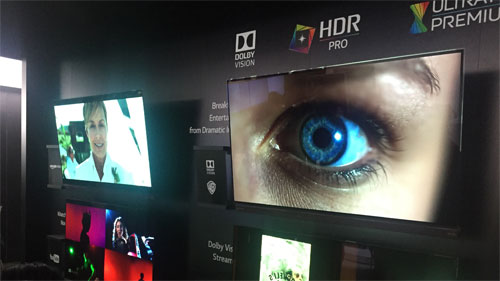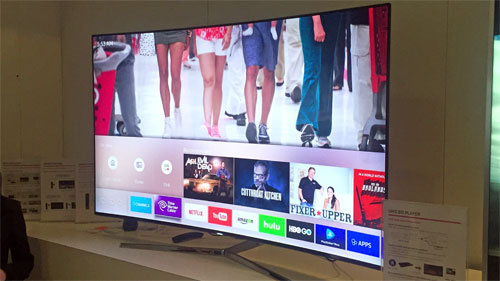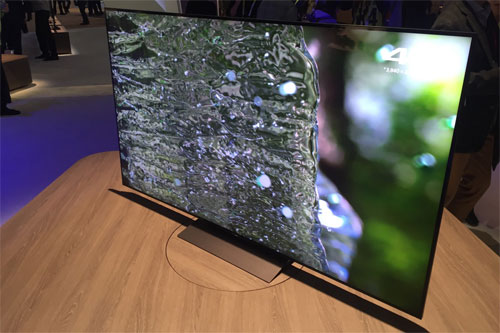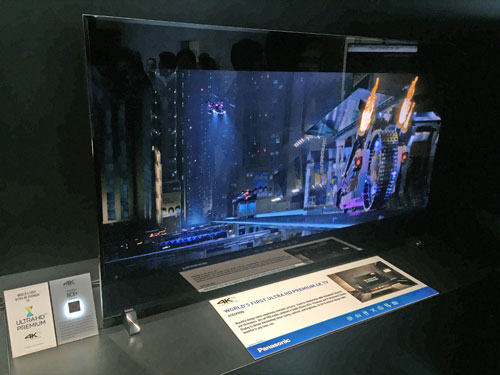Another new year, another CES. As the Las Vegas Convention Center once again emptied out earlier this month, journalists filed out of Clark County with a taste of what’s in store for the new year.

And, it’s a pretty familiar taste: with regard to our interest in consumer TV displays, this year’s show brought much of the same. LG Electronics continues to dominate the OLED world, essentially having the category all to itself thanks to its investment in, and perseverance with the next-generation display technology. Meanwhile, the most promiment remaining big names in the TV business – Samsung and Sony – are attempting to keep consumers interested exclusively with LED LCD technology, with Panasonic being the only other manufacturer even showing an OLED product.
Speaking of which, the fate of the Panasonic CZ950 OLED outside of Europe remains uncertain. While Panasonic presented it at the show, the corporation’s American arm did not actually announce the product Stateside, which does not bode well. CNET’s David Katzmaier last week shared news via Twitter that Panasonic USA contacts claim that reports promising a US launch for the product are merely “speculation”. Meanwhile, in Europe, where Panasonic has a significantly better market share in the TV business, the CZ952 is selling above the manufacturer’s own expectations, according to the company’s UK representatives. It would be a real shame if the CZ950 were to remain exclusive to Europe: we reviewed the UK variant, the TX-65CZ952B, earlier this month, and found it to be a marked improvement over LG’s own OLED TVs.
The uncertain worldwide availability, and price disparity, mean that LG OLED televisions will remain the torch-bearers for the emissive display technology. All of the South Korean brand’s 2016 OLED TV models will support the new Dolby Vision HDR standard, and meet the UHD Alliance’s “Premium” certification requirements. LG claim that the 2016 OLEDs can produce better than 500 cd/m2 of peak brightness when displaying HDR images, and that they can cover 99% of the DCI-P3 colour gamut that will surely be used for the majority of releases on the upcoming Ultra HD Blu-ray format. There are four ranges, and videophiles will rejoice in the news that only one of them is curved. LG has also announced a “Signature” model with premium styling.
Meanwhile, Samsung’s television division continues to say “no thanks” to OLED, and behind closed doors, the company gave journalists an in-depth technical seminar on what to expect on their liquid crystal efforts in 2016. As with last year, Samsung’s premium UHD (ultra high-definition) displays are branded “SUHD”, which has echoes of the firm’s decision in the late 2000s to invent a new marketing category of TV with the move towards the “LED TV” moniker.

The top-of-the-range display is the KS9500 (called KS9800 in North America), which appears very similar to last year’s JS9500. The improvements for the 2016 model come in the form of wider colour gamut (Samsung promise 98% of DCI-P3), better control over full-array local dimming “blooming” artefacts by compensating for them at the video processing level (although we’re not quite sure if that’s even possible with the classic example of white objects on a black background), and a feature called “Ultra Black”, which is Samsung’s marketing name for a “moth-eye” type screen filter. “Ultra Black” is said to nearly eliminate screen glare from bright room lighting. We’ve seen the same concept deployed on a Philips LED LCD TV in the past years (Philips simply marketed it as “Moth Eye filter”), and it worked wonderfully.
Samsung will surely be feeling the pressure from OLED, however, and we found it telling that the company did what they could to avoid referring to its products as LED or LCD TVs – the official terminology used was “SUHD Quantum Dot display” (Samsung have dropped the “NanoCrystal” term that they introduced last year). At their press conference, the company appeared to be subtly downplaying OLED’s display characteristics, drawing on company research that indicates the majority of US viewers watch TV in a brightly lit room. Samsung stated that their Quantum Dot LCD displays do not “compromise on brightness levels” (surely a reference to the 1000 cd/m2 peak light output possible with this LCD technology compared to the ~500 cd/m2 quoted for OLED) and that “SUHD TVs are designed for the way people watch TV in real life”, not people who live in “windowless caves”. The point isn’t completely motivated by the realities of OLED production, however: OLED’s biggest draw, its infinitely deep blacks, are best appreciated in a dark viewing environment. However, the wide viewing angle OLED technology affords over LCD gives it a distinct advantage even after room lighting is discounted.

Sony, too, displayed more LED-lit LCD TVs, namely the XD94 and XD93, which again, appear similar in performance to last year’s BRAVIAs and once again run on the Android TV platform. Sony have chosen not to get on board with the UHD Alliance branding, setting them apart from LG, Samsung and Panasonic. The most interesting part of Sony’s CES exhibit, from a television standpoint, was a prototype UHD HDR display which was displaying beautiful video from Sony Pictures’ own 4K-mastered content. Taken from the film Annie, the clip featured a helicopter flyover of downtown Manhattan (which, coincidentally enough, is where HDTVTest‘s US base of operations is located), with ultra-bright and ultra-detailed highlights. We noted, however, that Sony had designed the show wall in a half-hexagonal shape, which forced viewers to observe the prototype display on-axis. As with any LCD-based product, the contrast and colour qualities will rapidly deteriorate when viewed from the sides.
When quizzed over the economic feasibility of such a large number of local dimming zones, Sony confidently stated that when taken to product form, the concept could be produced in a cost-effective manner. Here’s hoping that this does indeed happen – it’s worth noting that the most impressive part of Sony’s exhibit was a prototype product which will not be available to buy anytime soon (if ever). In response to our “why no OLED?” question (something we feel was even more pertinent since the company is selling OLED broadcast monitors for post-production use), Sony’s response was the same of Samsung’s: Sony feels that LCD’s high brightness is more suitable for HDR and is a proven technology.

Finally, the single new Panasonic TV on show, the DX900 LED LCD, was hooked up to the company’s new UHD Blu-ray player, playing clips from The Lego Movie. As with the outstanding CZ950 OLED, the DX900 uses the 4K Studio Master processor and has benefited from collaboration with Hollywood colourist Mike Sowa. Panasonic has also made changes to the LCD structure itself, employing a “honeycomb” structure which is said to combat the LED LCD full-array local dimming problem of blooming, where luminance intended for one portion of the screen spills into others. (It’s interesting to note that this is a physical difference, whereas Samsung’s answer to the issue was to address it in video processing). Panasonic promises more details to follow at its European convention event, which is being held in Frankfurt in February.
So, that’s CES 2016! It’s going to be an interesting year – the launch of Ultra HD Blu-ray Disc players from Panasonic and Samsung (and later, we’re promised, also from Sony) will finally allow HDR-capable TVs to shine by providing a high quality content source not hampered by internet bandwidth limitations. Will LED LCD’s brightness strengths produce a more compelling HDR image than OLED? Or will the self-emitting technology’s insanely dark blacks win over the hearts and minds of consumers? Time will tell, but we just hope that this time next year, we’ll be looking forward to some more manufacturers bringing some extra variety and competition to the OLED marketplace.